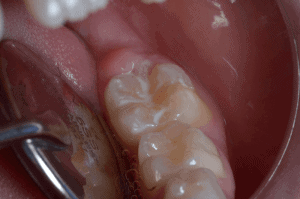What are dental sealants?
Dental sealants, also known as pit/fissure sealants, are thin resin coatings used to seal over the pits and fissures and grooves of your teeth to prevent decay from developing in these areas of your tooth. These areas are usually on the biting surfaces of your molar teeth. Sealants may be white or tooth-coloured.

Why are dental sealants beneficial?
The enamel surfaces of your teeth have grooves (fissures) and pits that develop while the tooth is forming. These fissures may be very deep and can be extremely difficult to clean. When food particles and bacteria accumulate in the fissures, a cavity may form over time. When a sealant is placed, these pits and fissures are isolated from harmful bacteria creating a smooth surface that is easily cleaned.
The process of cleaning out these fissures may also uncover incipient decay in its early stages. This early fissure decay may not be detected on dental xrays. Getting a fissure sealant early can halt the decay process.
Elite Dental Group uses BPA-free dental sealants. BPA is an endocrine disruptor that may affect the endocrine and reproductive systems in pregnant or nursing mothers and young children.

Who would benefit from getting dental sealants done?
- Teenagers and Adults with deep bacteria stained fissures in their permanent teeth
- Young children and teenagers and adults who are prone to decay
Dental Sealants at Elite Dental Group
Step 1: Examination
We will examine your teeth and go over your dental history (for eg: previous treatments, previous fillings). We will then advise you on whether or not you would benefit from sealants in your case.
Step 2: Preparing your tooth
First, we will open up the fissures to clean out stains and bacteria. The fissures and the surrounding tooth surface is also cleaned of plaque. Then, your tooth is isolated from saliva. A chemical etchant is applied to microscopically roughen the enamel surface. This is rinsed off and your tooth is then dried carefully.
Step 3: Applying the sealants
A thin layer of adhesive is applied to the dry tooth surface followed by the sealant. A strong blue LED light is used to harden the sealant and bond it to the enamel. The new sealant is checked to ensure that it does not interfere with your bite. The sealed surfaces are then polished.
Do note that dental sealants are also subjected to wear and tear and they need to be replaced from time to time.
[su_button url="other_services" style="default" background="#003853;" size="6" wide="yes" center="yes" radius="0"]TO SERVICES[/su_button]





